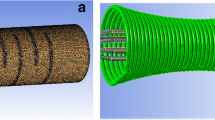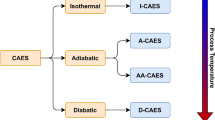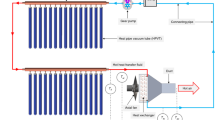Abstract
A challenging issue that arises in achieving a combined cycle with concentrated solar power technology is the development of a solar receiver for compressed air. A solar receiver transfers heat from concentrated solar radiation to compressed air so that the air temperature is sufficiently increased to drive an air turbine. Using a simple modular extension, we have developed three solar receivers for compressed air based on the concept of the tubular receiver. Conventional tubular receivers are generally applied in liquid fluids, such as water or molten salt. Cavities and extended surfaces were designed and incorporated into the developed tubular receivers to improve the heat transfer to air. The receivers were also subjected to performance evaluation tests, which were conducted in the solar furnace of the Korea Institute of Energy Research, with ambient air compressed at 5 bar and expressed in terms of outlet temperature and receiver efficiency. Test results indicated the thermal characteristics of the three solar receivers for their proper use and facilitated the comparison of their performances. The results also provided a guideline to construct and simulate a solar receiver system composed of a series of receiver modules. The problems identified in this study can help improve the solar receiver system.
Similar content being viewed by others
References
M. Romero-Alvarez and E. Zarza, Concentrating solar thermal power, Energy Efficiency and Renewable Energy handbook, Taylor & Francis, New York, USA (2007).
IEA, Technology roadmap concentrating solar power, www.iea.org/publications/freepublications/publication/csp_r-admap.pdf (2010).
K. Lovegrove and W. Stein, Concentrating solar power technology: Principles, developments and applications Woodhead Publishing, Woodhead Publishing, Cambridge, UK (2012).
P. Schwarzbözl, R. Buck, C. Sugarmen, A. Ring, M J. Marcos Crespo and P. Altwegg, Solar gas turbine systems: design, cost and perspectives, Solar Energy, 80 (10) (2006) 1231–1240.
R. Buck, T. Bräuning, T. Denk, M. Pfander, P. Schwarzbözl and F. Tellez, Solar-hybrid gas turbine-based power tower systems (REFOS), Journal of Solar Energy Engineering, 123 (1) (2002) 2–9.
G. Barigozzi, G. Bonetti, G. Franchini, A. Perdichizzi and S. Ravelli, Thermal performance prediction of a solar hybrid gas turbine, Solar Energy, 86 (7) (2012) 2116–2127.
P. Heller, M. Pfander, T. Denk, F. Tellez, A. Valverde, J. Femandez and A. Ring, Test and evaluation of a solar powered gas turbine system, Solar Energy, 80 (2006) 1225–1230.
U. Fisher, C. Sugarmen, A. Ring and J. Sinai, Gas turbine solarization: modifications for solar/fuel hybrid operation, Journal of Solar Energy Engineering, 123 (3) (2004) 872–878.
A. Kribus, P. Doron, R. Rubin, J. Kami, R. Reuven, S. Duchan and E. Taragan, A multistage solar receiver: the route to high temperature, Solar Energy, 67 (1) (1999) 3–11.
A. L. Ávila-Marín, Volumetric receivers in solar thermal power plants with central receiver system technology: a review, Solar Energy, 85 (5) (2011) 891–910.
L. Amsbeck, R. Buck, P. Heller, J. Jedamski and R. Uhlig, Development of a tube receiver for a solar-hybrid microturbine system, Proc. of 14th SolarPaces Symposium, Las Vegas, USA (2008).
I. Hischier, D. Hess, W. Lipinski, M. Modest and A. Steinfeld, Heat transfer analysis of a novel pressurized air receiver for concentrated solar power via combined cycles, Journal of Thermal Science and Engineering Applications, 1 (4) (2009) 041002.
I. Hischier, P. Leumann and A. Steinfeld, Experimental and numerical analyses of a pressurized air receiver for solardriven gas turbines, Journal of Solar Energy Engineering, 134 (2) (2012) 1–8.
H. S. Cho, H. J. Lee, J. K. Kim, S. N. Lee and Y. H. Kang, Design and performance evaluation of solar air receivers, Journal of The Korean Solar Energy Society, 32 (3) (2012) 207–212.
H. J. Lee, K. K. Chai, C. K. Yu, J. K. Kim and Y. H. Kang, Design and performance evaluation of a solar receiver using metal foam for compressed air, Proc. of the Korean Solar Energy Society Spring Conference, Daegu, Korea (2013) 120–125.
S. Lim, Y. Kang, H. Lee and S. Shin, Design optimization of a tubular solar receiver with a porous medium, Applied Thermal Engineering, 62 (2) (2014) 566–572.
H. J. Lee, K. K. Chai, J. K. Kim, S. N. Lee, H. K. Yoon, C. K. Yu and Y. H. Kang, Optical performance evaluation of a solar furnace by measuring the highly concentrated solar flux, Energy, 66 (2014) 63–69.
H. J. Lee, J. K. Kim, S. N. Lee and Y. H. Kang, Heat flux analysis of a solar furnace using the Monte Carlo ray-tracing method, Transactions of the Korean Society of Mechanical Engineers B, 35 (10) (2011) 989–996.
B. Hoffschmidt, F. M. Tellez, A. Valverde, J. Fernandez and V. Fernandez, Performance evaluation of the 200-kWth HiTRec-II open volumetric air receiver, Journal of Solar Energy Engineering, 125 (1) (2003) 87–94.
A. Kribus, H. Ries and W. Spirkl, Inherent limitations of volumetric solar receivers, Journal of Solar Energy Engineering, 118 (1996) 151–155.
C. Kennedy and H. Price, Development and testing of hightemperature solar selective coatings: NREL/CP-520-36581, National renewable Energy Laboratory, USA (2005).
I.S. Han, D. W. Seo, S. Y. Kim, S. K. Woo, H. J. Lee and B. K. Jang, Performance-properties and fabrication of the reaction sintered Si/SiC honeycomb materials for solar absorber application, Journal of the Ceramic Society of Japan, 126 (6) (2014) 502–508.
Author information
Authors and Affiliations
Corresponding author
Additional information
Recommended by Associate Editor Jae Dong Chung
Ha Neol Kim is a master’s student in Mechanical Engineering at Inha University (Korea). He received his B.S. degree from Korea National University of Transportation in 2013. He is currently a research assistant in KIER. His research focuses on solar receivers, chemical reactors, and the thermal storage of molten salt.
Hyun Jin Lee holds a major in mechanical engineering, specifically radiative properties and heat transfer. He received his masteral and doctoral degrees from Seoul National University and Georgia Institute of Technology, respectively. He joined the Korea Institute of Energy Research in 2009 and has since been studying solar thermal energy.
Rights and permissions
About this article
Cite this article
Kim, H.N., Lee, H.J., Lee, S.N. et al. Experimental evaluation of the performance of solar receivers for compressed air. J Mech Sci Technol 28, 4789–4795 (2014). https://doi.org/10.1007/s12206-014-1046-x
Received:
Revised:
Accepted:
Published:
Issue Date:
DOI: https://doi.org/10.1007/s12206-014-1046-x




